2415
Views & Citations1415
Likes & Shares
Many researches have researched, proved and published many thesis, dissertations, scholarly papers, essays and articles about the benefits and the positive impacts of doing regular physical activities (exercise, sports, sports participations, and other related physical activities) on students’ academic and overall personal development. However, most of these studies were done on quantitative approach on cross-sectional population, synchronically. Very few qualitative longitudinal case studies have been done in this field, especially covering a long period of time, in Taiwan region. Not only checking the benefits and positive impacts of physical activities synchronically, it is also very important to check what changes can regular involvement in sports and physical activities bring on students’ lives in the long run. The present study is a qualitative, longitudinal single case study, which investigated the benefits and positive impacts of doing physical activities on a single male student’s academic performance as well as on his overall personal development through observation, documentation, and interviews for a period of nine and half years of compulsory education in Taiwan region.
The sad news is that, in spite of all the benefits sports and physical activities contribute, it was found that, in Taiwan region, more and more students stayed away from these beneficial physical activities (Ngangbam, 2021). Thus, the overall purpose of the present study is to investigate the benefits and positive impacts of sports and physical activities on the case study subject’s academic performance and overall personal development. The study also presents some suggestions on how to encourage and let students stay close to exercise and sports habits so that their lives can be more rounded and complete.
LITERATURE REVIEW
The present study investigates the benefits and positive impacts of sports and physical activities on students’ lives. Many scholarly research papers, articles, thesis, dissertations have been written and published on journals, magazines and online about the benefits and impacts of sports and sports activities. This section will study some of the relevant and related studies done by other scholars in this field.
In spite of all the benefits and positive impacts sports and physical activities contribute, sadly, very few students, even their parents and teachers give less thoughts and importance of these activities to student community. This negative attitude has kept many young students away from sports and physical activities, especially in Taiwan region.
According to Ngangbam’s study (2021), in Taiwan, 82% of students knew doing physical activities could keep them physically and mentally fit and healthy, but only 28% of them did enough exercise.
Studies have consistently demonstrated that physically active people are not only healthier but also perform better on tests of cerebral or intellectual ability. John J. Ratey, a Harvard University psychiatrist, in his book Spark: The Revolutionary New Science of Exercise and the Brain (2008), describes the increased volume in the hippocampus and frontal and temporal lobes, the regions of the brain associated with cognitive functioning, through MRI scans of the brains of sedentary people who have suddenly improved their fitness levels.
According to Gorton on James Coleman’s classic work, “The Adolescent Society” (1961) students who participate in high school sports tend, on average, to perform better academically than their non-athletic peers. However, the positive impact of physical activities on academic performance on students also depends on the level of physical activities of the students.
The level of academic performance also depends on the level and frequency of involving in sports and physical activities. In his study, Laughlin examined the grades of wrestlers during the season and out of season at a rural high school in Iowa and found that athlete-students do better in academic during the training season than off-season. He found that the wrestlers earned higher grades during the wrestling season than out of competition, meaning the more regular physical activities, the better in academic performance. Laughlin’s findings were also supported by Quirk and Silliker’s study. Their study revealed that the in-season grades were substantially higher than out-of-season grades (Laughlin, 1972, Quirk & Silliker, 1998 as cited in Gorton, 2010, 15).
Sitkowski, (2008) in his study also found that athletic participation had a positive impact on academic performance and that impact may be attributable to the difference between in season and out of season performance. During his Ph. D. data analysis, it was found that there was a significant difference between the GPA (Grade Point Average) scores during and after participating in school-sponsored sporting events for male students.
Most parents might think that spending time on sports and physical activities will reduce their study time. However, according to CorneliBen & Christian, (2007) time spent on sport does not necessarily reduce the time allocated to schooling but can also reduce bad leisure activities, which might harm educational productivity, for examples, activities like watching television, playing computer games, smoking, drinking, and going to parties. If participation in athletic activities reduces these bad activities, sport can have an indirect positive effect on educational productivity.
In his study for Master’s thesis, Prasad, (2012) compared two groups of students. It was found that students who participated in sports generally did better than those who did not.
To keep students away from sedentary lifestyle, Sharma, (2019) states those parents should become role models in doing physical activities in their children’s lives to keep them away from the addiction to these techie-gadgets, so that their kids can also have an active lifestyle.
Regarding how exercise and physical activities work, according to Hillman (Hillman et al., 2008, as cited in Christopher, 2017, para. 6). One key causal mechanism underpinning the relationship between physical activity and academics is a direct, physiological link between activity and cognition. Evidence from the biological and neurological sciences suggests that physical activity activates the allocation of cognitive resources and promotes faster cognitive processing through stimulus encoding.
Donnelly et al, (2016) also found the evidence to suggest that there are positive associations among physical education, fitness, cognition, and academic achievement. Based on the evidence available, they concluded that physical education has a positive influence on cognition as well as brain structure and function.
In a two-year, with three-time points longitudinal study of five public junior high schools in two suburban municipalities in Okinawa prefecture, Japan from April 2015 to July 2017, Kyan et al. (2018) detected a possibility that an increase in physical fitness leading to good academic achievement among junior high school boys, regardless of between-person differences of physical level.
In a two-semester study in a Shanghai high school to examine the effect of a strengthened physical education pilot program consisting of specialized sports training on students’ academic performance in the high school context, Zhang et al. (2019) found that strengthened physical education had a significantly positive effect on overall academic performance among the high school students, especially in Chinese language and English language scores.
Recently, in their longitudinal study of 7, 11 and 14-year-old students, Vasilopoulos and Ellefson, (2021) examined the relationship amongst physical activity, self-regulation in a multi-dimensional approach and educational outcomes. They found out that emotional regulation was linked to physical activity in early childhood to subsequently affect academic achievement.
Doing sports and physical activities is not just about regularity, it is also about intensity. In their study Joca Zurc & Jurij Planinšec, (2022) found that children engaged in physical activity most days a week, with moderate-intensity and unorganized activities showed significant associations with above-average academic competence. The higher frequency and intensity of physical activity, the absence of digital games, and attending sports clubs seem to have the most beneficial effects in terms of academic competence in school children.
On their study on participation in sports and games as well as extracurricular activities and development of personal and interpersonal skills in adolescents, Ivaniushina and Zapletina (2015) revealed that students who participated in sports and games activities offer a wide variety for developing various aspects of personality such as social skills, interpersonal skills, and goal setting skills, self-identity and competencies.
In their study, Lazaro & Anney, (2016) found that students who participate in co-curricular activities such as sports and games are more advantageous to developing talents, including enriching students’ language skills and self-confidence.
Massoni, (2011) in his study found that students who participated in extracurricular activities reduced behaviors problems. Students who participated in these activities take pride in their accomplishments; hence they gain better self-respect, self-esteem and self-confidence.
Elavsky, (2010) states that, regardless of weight, size, gender, or age, exercise can quickly elevate a person's perception of his or her attractiveness, that is, self-worth.
Based on their study on 34 male and female high school students divided as experimented (15) and control groups (19), Soyturk & Ozturk, (2020) revealed that among the high school students’ behaviors, sports-based games are effective activities which can be used in reducing high school students’ behavior problems.
In their study “Extra-curricular activities and youth risky behaviors in South Africa” including a sample of 10,502,705 including both male and female youths aged between 12-22, Muloiwa & Odimegwu, (2018). It was revealed that participation in sports and games as well as extracurricular activities were found to be beneficial to youth self-esteem and discipline.
In spite of all these benefits sports and physical activities provide, more and more teenagers/adolescents stay away from physical activities. Many researchers have proved that increasing time for physical activities in schools help students to improve their academic performance. However, time for physical activity classes have been limiting to less than 2 h per week in Taiwan region.
Concerning the factors which keep young and adolescent students away from these physical activities, according to Ngangbam’s (2021) study, the main responsible factors which keep Taiwanese students away from doing sports and physical activities were busy on school works, part-time jobs, not enough social and family supports and encouragements, lack of interest, lack of knowledge, no self-confidence in sports, and too little time given on physical education respectively. To support and encourage children and adolescents to be active in physical activities, parents must play an important role.
Aerts et al, (1997) stated that while physical activities appear to be a natural part of children's everyday life, they declined during adolescence period. This finding was supported by Kimm et al, (2002) study of 1213 black girls and 1166 white girls from the ages of 9 or 10 to the ages of 18 or 19 years. They found that these girls’ physical activity level declined during adolescence. Casey et al, (2009) reported that participation in sport and physical activity declined during adolescence.
Considering the declining trend in the adolescent and adulthood, (Crumbley et al,2019). talked about the importance of instilling a habit of doing physical activities during childhood. They stated that as physical activity and sedentary behaviors are developed during the early childhood period, for physical activity to occur in children, parents should also be engaged in and model the physical activity behaviors, increasing the likelihood of young children learning to be physically active.
In another study by Hosseini et al, (2013) two main themes were found played by parents: developing interest in physical activity and providing support to adolescents for physical activity through role model and support.
Not only parents’ involvement in physical activities plays an important role in supporting and encouraging children and adolescents to involve in physical activities, according to Qurban et al, (2018) those children and adolescents who involve in physical activities regularly are found to be more supported by their parents. They continued that greater parental support will result in enhancing students’ academic motivation, skills and knowledge about school goals, thereby resulting in better academic achievement. Besides these benefits, physical activities also bring parents and children closer.
Based on these studies mentioned above, there are numbers of benefits sports and physical activities contribute to student community. In fact, sports and physical activities are like the backbones in the lives of students. Not only for children and students, sports and physical activities are important to all human beings to keep themselves fit and healthy - mentally and physically.
But the sad news is that few people, parents, even educated teachers and professors don’t really take it seriously to be the role models to encourage their children and students to do sports and physical activities regularly. If not role models, at least parents should encourage and support their children to live an active life instead of wasting their time, energy, and health addicted to techie-gadgets.
RESEARCH METHODOLOGY
The present study is a qualitative, descriptive, longitudinal, diachronic, non-experimental, non-controlled, and non-participant, covered case study, which investigated the benefits, positive impacts of exercise, sports and physical activities on academic performance, and overall personal development on a single male case study subject. The present case study research is based on the data collected through triangulation data collection approach through observation, documentation and face-to-face interviews conducted longitudinally for a period of nine and half years of compulsory education in New Taipei City and Kaoshiung City, Taiwan region.
The reason behind opting a longitudinal single case study approach within the qualitative method is that it allowed the researcher to investigate what changes were brought under the influence and impacts of sports and physical activities on the present case study subject longitudinally over a period of nine and half years. And the main reason for choosing these three periods of elementary, junior and senior high schools is that sports and other physical activities (physical education classes) are compulsory during these schooling years in Taiwan region. There are two 50-min compulsory physical activity classes per week. These physical activity classes are taught as credit courses and grades are given according to their physical activity performance by their PE (physical education) teachers. Besides these PE classes, there are many sport clubs, which students can join depending on their interest. Thus, students can practice as many times as they need to.
To find out the link between the case study subject’s sports and physical activities performance and academic performance and overall personal development, the present study observed the case study subject’s involvement in sports and physical activities in school and outside the school, checked his physical activity and study grades, and used original documents and interview responses. The researcher also checked his overall personal development during the study period.
Case Study Subject
The case study subject is a male student. He is the last child among four siblings (The researcher is the biological father). He studied his elementary and junior high school for sox and three years respectively at Qingshui Elementary School and Qingshui High School, Tucheng District, New Taipei City, Taiwan, during 2013 to 2022. Now, case study subject is studying his senior high school first year. Right now, case study he is studying his senior high school at Taiwan National Military Academy, Kaoshiung city, Taiwan.
The main reason for choosing the present case study subject was that he was doing well in both sports and study. At the beginning this case study research, case study subject was around 7 years old. He was serious, hardworking, and responsible in exercise as well as in study. He hardly missed his exercise, sports and other physical activities as well as his study. The only missing days were when he was sick or had an appointment outside of school. The researcher found the case study subject as was one of the right students from whom the researcher could investigate the benefits and impacts of regular exercise, sports, and other physical activities on the case study subject’s academic performance and overall personal development.
The other point for selecting this subject of case study was that the researcher being the father of the case study subject, it was much easier for the researcher to access the case study subject to observe closely and note down the necessary details of the case study subject’s involvement in exercise, sports, sports activities, check his PA and academic grades, performances, and overall personal development over a long period of time 9 and half years.
Definition of Case Study
Kenneth Harling, (2012) defines case study as a holistic inquiry that investigates a contemporary phenomenon within its natural setting. To elaborate, it means to investigate a phenomenon which can be a program, an event, an activity, a problem or an individual through in-depth and detail direct observations, interviews, audio-visual materials, documents, reports and physical artifacts in natural contextual conditions within which this phenomenon appears.
According (Creswell,2007). "case study research is a qualitative approach in which the investigator explores a bounded system (a case) or multiple bounded systems (cases) over time" through detailed, in-depth data collection involving multiple sources of information (e.g. observations, interviews, audio-visual material, and documents and reports) and reports a case description and case based themes.
On the other hand, Stake, (1995) defines case study as “the study of the particularity and complexity of a single case, coming to understand its activity within important circumstances” (p. xi), giving his attention on the nature of the “case” as well as its context.
The present case study is an investigation of an individual through in-depth and detail direct observations, interviews, documents in natural contextual conditions within which this phenomenon happens. The following section will explain the details about data collection and analysis approach.
Data Collection and Analysis
To make the data more reliable, valid, authentic, objective and measurable, the present investigation used triangulation data collection approach - observation, documentation, and interviews. The data were collected during case study subject’s education during elementary, junior, and senior high school (first semester) compulsory education in Taiwan. The three data collection procedures are presented below.
Observation of the case study Subject
To know the detail benefits and impacts of sports and physical activities on the case study subject, the researcher needed to observe the case study subject in three steps.
First, researcher observed the individual case subject’s involvement in physical activities (exercise, sports, sports activities) on daily or weekly basis, depending on the time available to the researcher especially after school, as well as checking periodically the case study subject’s PA performance scores (grades) for a total of nine and half years (19 semesters).
During his elementary school study, case study subject had two 50-min physical education classes per week. On these two periods of physical activity classes on two different days, students were allowed to play different sports like basketball, volleyball, badminton, soccer, and running. He took part in all those activities. Besides these activities at school, case study subject also did physical activities like running and rope skipping at home, or in the local parks after school, or on weekends. Overall, he did very well in both physical activities and study.
By the beginning of the first year of his junior high school, besides the two 50 min physical education classes, the case study subject joined school Wushu Club. However, he was not serious in his Wushu or physical activities (The reasons will be given in the discussion section). Thus, by the end of his first year of junior high school, his PA average grade points for the first and second semesters were 74.3% and 75.5% respectively, giving an average PA average grade point of 75% by the end of his first year junior high school. In all his study career so far, case study subject never got this low average grade point in physical education.
Regarding his academic performance, case study subject was still doing good scoring 90.6% and 90.4% respectively in the first and second semesters, leading to an average study grade of 91% in his study by the end of the first year junior high school.
However, when the case study subject became more serious and involve fully in Wushu sports and other physical activities during the second year of his junior high school, his PA and study average grade points improved to 84% and 93% respectively. He continued improving in his PA activity level and frequency, thus helping him to score average grade points of 91% in PA and 93% in study by the end of his junior high school.
Now, by the end of January 2023, case study subject has just finished his first semester of first year senior high school which started by the second half of 2022. Following his sports and physical activity habits, case study subject did very well in his PA class scoring 91% at the first semester. However, his study grades didn’t go as high as his PA grade. He got 83% in average by the end of his first semester of his senior high school. The next part will present the original grade sheets and other relevant documents. The following part will talk about the second step.
Collection of documents
Second, to see the benefits and impacts of sports and physical activities on the case study subject’s academic performance and overall personal development, case study subject’s PA (exercise, sports and sports activities) and study average grade points during his elementary, junior, and one semester senior high school were collected from his school and used for the present research. The following documents in Figures 1-4 display the case study subject’s original school grade sheets and his ranking. For privacy reason the name and student numbers aren’t disclosed.
The above document in Figure 1 displays the original grades of all the subjects during six years of elementary school. For convenience, clarity, and necessity, only the PA and study average grade points were translated into English and displayed.
The above document in Figure 2 displays the original grades of all the subjects during three years of junior high school. For convenience, clarity, and necessity, only the PA and study average grade points were translated into English and displayed.
The above document in Figure 3 displays the original grades of all the subjects during the first semester of senior high school. For convenience, clarity, and necessity, only the PA and study average grade points were translated into English and displayed.
The above document in Figure 4 displays the original grades of all the subjects and the rankings during the first semester of senior high school. For convenience, clarity, and necessity, only the PA and study average grade points were translated into English and displayed. By the end of his first semester of senior high school, case study subject ranked top six in his class and top 15 among the 600 newly recruited students. Following section gives the detail about interviews data collection approach.

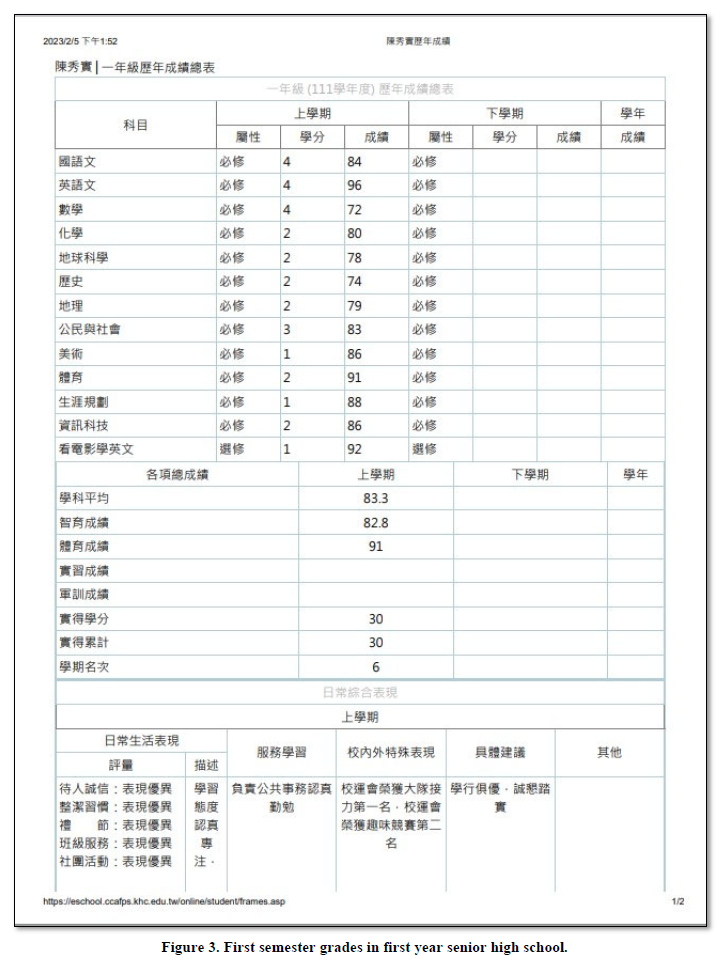
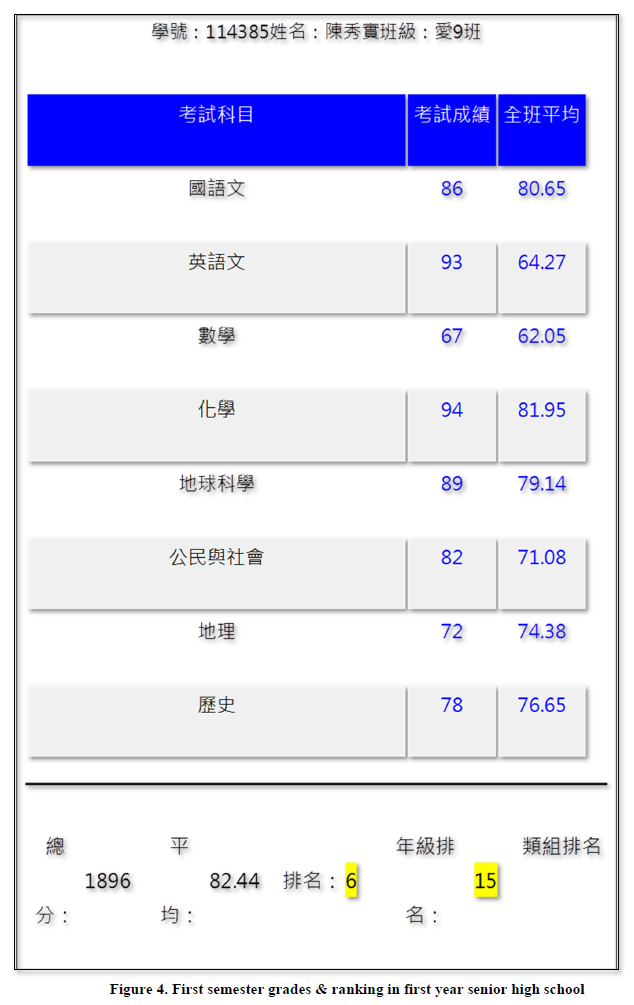
Face to face Interviews
The third data collection was done through face-to-face interview with the case study subject, especially to find out relevant information which the researcher could not observe directly and also to know the case study subject’s emotional and psychological behaviors. The researcher used mostly unstructured open ended questions. The following table display the questions used during the interviews (Table 1).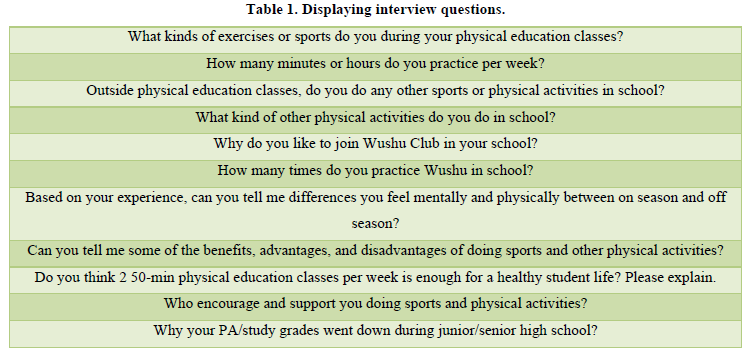
The research interview responses are presented as text whenever necessary to comment or explain, especially in research methodology and discussion section.
Research Findings
The present research investigated the benefits and positive impact of doing regular exercise, sports and physical activities on a single male student’s academic performance and his overall personal development.
Elementary School (Table 2 & Figure 5)

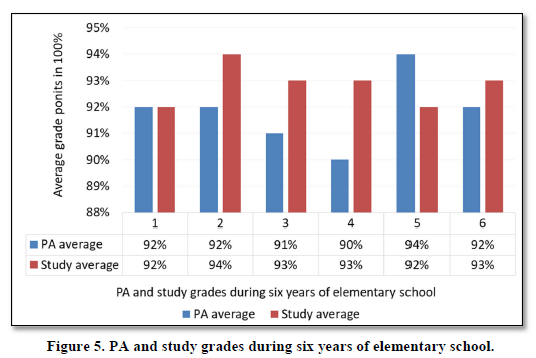
Junior High School
The PA and study grades in the following table in Figure 6 were extracted from the original school grade sheet in Figure 1 to display the PA and study grades for elementary school especially for those who cannot read Chinese characters. However, the detailed scores for each subject were not extracted as they were not important for the present study (Table 3).

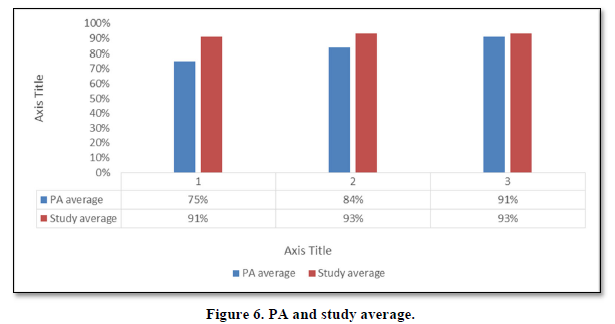
Senior High School
The following Table 4 and chart in Figure 7 displays the case study subject’s PA and study grades for the first semester in senior high school (2022-23), which were extracted from the original copy in Figure 3.
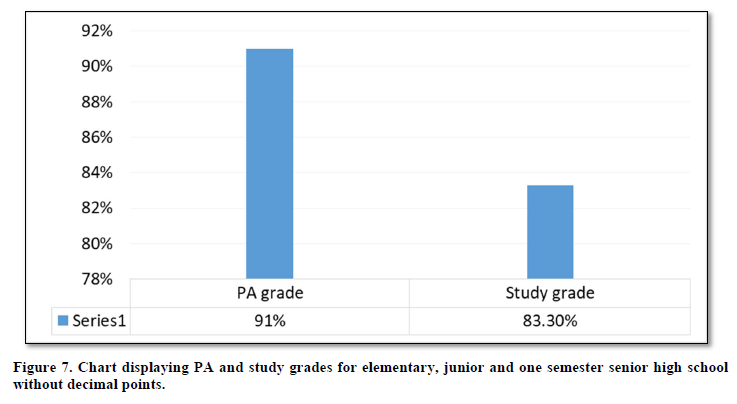
For space, convenience and clarity, all the PA and study grade points for elementary school, junior high school and one semester senior high school were combined into a Table 5 and chart as given below in Figure 8.

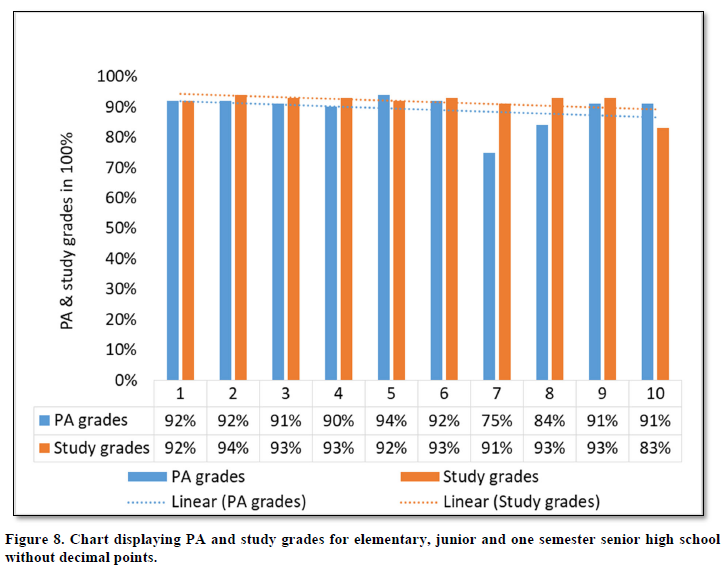
The following section will discuss the research findings - the links, the patterns, and the trends.
RESEARCH DISCUSSION
The present research investigated longitudinally the benefits and the impacts of sports and physical activity on academic performance and overall physical and personal development on the case study subject through observation, documentation, and interviews during the case study subject’s nine and half years of compulsory education in Taiwan (still going on). The following combined table and chart display some of the important findings.
For space and convenience of analysis and presentation, case study subject’s PA and study average grade points for elementary, junior and one semester senior high school were combined into a Table 6 and chart as follows in Figure 9.
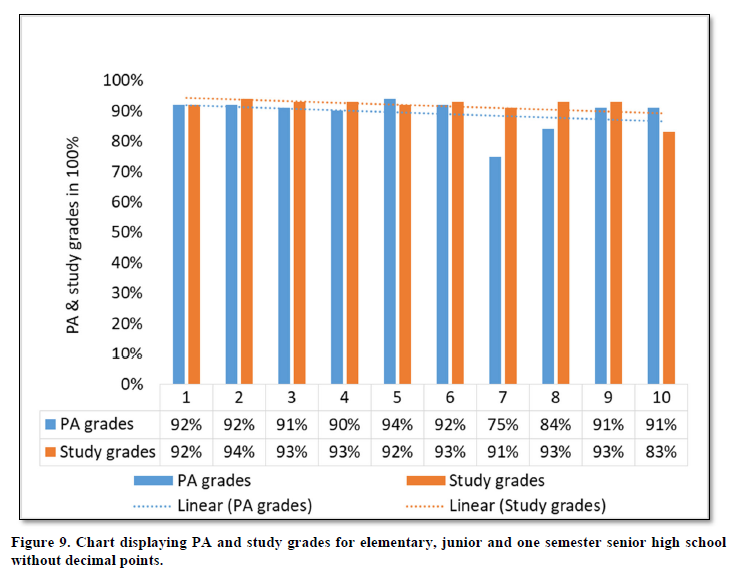
From the PA and study average grade points during the nine and half years of compulsory education in Taiwan, five important results were found. First, there was strong link between case study subject’s PA average points and study average points as found by scholars like Coleman (1961); Laughlin (1972); Quirk & Silliker (1998); Gorton (2010); and Sitkowski (2008).
When the case study subject got PA average grade points above 90% during his nine and half years of compulsory education, he also got study average grade points above 90% in study, except year 7th when he got 75% in PA and year 10th when he got 83% in study. The reason for the lowest 75% PA average grade point, according to case study subject’s interview response are quoted here “I was naughty and wasn’t so serious about sports or physical activities. I was just following my elder sister” He continued “My parents also didn’t talk much about my exercise”. Yes, his parents were too focusing on their daughter’s Wushu practice, competitions, and her sports achievements. The case study was neglected unnoticed to his parents. Anyway, luckily, case study subject managed to get 91% in his study.
However, during the second year of junior high school, he became serious in his Wushu sports as well as in his physical education classes and other physical activities. Besides his school Wushu practice and physical education classes, now case study subject started training his muscles at home using some free weights. He also did chin ups, sit ups, push-ups. Time to time, case study subject also 2,000 - 5,000 meters running at the local park to increase his stamina. He followed the same habits till the end of his junior high school.
Thus, when the case study became more serious and involves fully in Wushu sports and other physical activities during the second year of his junior high school, his PA and study average grade points improved to 84% and 93% respectively. The case subject kept improving in his PA activity level and frequency, thus helping him to improve both his PA and study average grade points to 91% and 93% respectively by the end of his junior high school.
These findings clearly suggest that both children and adolescent students need to be encouraged and supported by their parents constantly (Aerts et al., 1997; Kimm et al.,2002; Casey et al., 2009; Crumbley et al., 2019; Hosseini et al., 2013).
Second, there was a strong link between the case study subject’s involvement and frequency level in sports and physical activities and his academic performance. Higher intensity and higher frequency in physical activities yielded better academic results as found by Kyan et al. (2018), and Joca Zurc and Jurij Planinšec (2022) in their studies.
Third, as stated by Aerts et al (1997); Kimm et al. (2002); and Casey et al. (2009) a slight declining tendency was found in both physical activity and academic performance over the course of the study as can be seen from the trend lines on PA and study chart in figure 10 above.
Fourth, through the present case study subject, it was also found that doing sports and physical activities regularly not only helped the case study subject to be active, energetic and healthy, but also helped him to outperform academically those physically non-active students as found by Coleman (1961 as cited by Gorton) and (Gorton,2010).
Fifth, doing regular exercise, sports, physical activities and taking part in sports activities helped the case study subject to be more discipline, to respect others, stay away from behavioral problems, instilled a sense of team spirit, hardworking, self-respect, self-esteem, self-confidence, happiness, and taught him social and interpersonal skills, language skills and the will to bear pain (Elavsky, 2010; Massni, 2011; Ivaniushina & Zapletina, 2015; Lazaro & Anney, 2016; Muloiwa & Odimegwu, 2020).
Since the case study subject started to be serious in his sports and physical education, He has also become stronger, faster, and more fit than ever. He also grew up faster, taller, and became more handsome. Mentally and personally, the case study subject has become more matured and understanding. One of the best case study subject has learnt from doing sports and other physical activities is that he has leant the meaning of “No pain no gain” - how to bear pain and suffering through hard training and persistent.
Now, at his senior high school at the National Military Academy, because of all these years of involving in sports, physical education classes and sports participations, case study subject is able to deal with any problems in his new military academy. He never complained about his study or physical activities their so far. He continues his habits of doing sports and exercise. There is no Wushu club at this school. However, like before, he does other physical activities like running, pushups, chin-ups, sit ups and stretching almost every day in his room or in the campus. Whenever he comes home his Taipei home, he would do his weight training at home. Seeing his interest in sports and building his muscles, recently, his father admitted him to a local gym, and he trained with his father. He is getting stronger, healthier, happier, and more handsome.
One of the best things about staying in touch with sports and physical activities is that, through his busy schedule in study, exercise, and sports activities, case study subject does not have much time to spend on digital screens. In fact, World Health Organization is so much worried about the negative effects of excessive use of modern gadgets, like mobile phones on young teenagers and adolescents’ physical and mental health.
In spite of all these getting all these benefits from sports and physical activities, the present case study subject cannot be left alone thinking he will do all these physical activities by himself. His parents need to encourage and support him constantly as physical activity levels declines when they enter adolescent stage (Aerts et al., 1997; Kimm et al., 2002; Casey et al., 2009).
Research Limitations
The present study has its own limitation. As the present investigation used only one case study subject the findings cannot be compared with other students whether athletic or non-athletic students. However, despite the limitation, based on the research findings, it can be suggested that if doing regular exercise, sports and other related physical activities helped the case study subject physically, mentally, academically and in developing different aspects life, then this good habits also will work well for other individuals, if parents can constantly encourage and support their children to do exercise, sports and physical activities.
Research Implications
The findings of the present study suggest that doing exercise, sports and sports related physical activities can be beneficial to both children and adolescent students. The findings also suggest that these activities not only can help students to be physically and mentally healthy, but also can help them to do better in their academic fields and overall personal development. Through these research findings, it can be suggested that parents should change their indifferent attitudes towards the benefits and positive impacts of sports and physical activities on students’ academic performance and overall personal development. However, it should be remembered that teenager and adolescent students need constant encouragement and support from their parents.
CONCLUSION
In conclusion, the present case study research qualitative, longitudinal case study which investigated the benefits and impacts of doing regular exercise, sports, sports participation and physical activities on a single case study subject. The research data were collected through triangulation data collection approach - observation, documentation, and interviews. From the present investigation, five important things were found. First, there was strong link between case study subject’s PA average points and study average points. Second, there was a strong link between the case study subject’s involvement and frequency level in sports and physical activities and his study performance. Higher intensity and higher frequency yielded better academic results. Third, a slight declining tendency was found in both physical activity and academic performance over the course of the study. Fourth, through the present case study subject, it was also found that doing sports and physical activities regularly not only helped the case study subject to be active, energetic and healthy, but also helped him to outperform academically those physically non-active students. Fifth, involving in exercise, sports and sports activities helped the case study subject to be discipline, to respect others, stay away from behavioral problems, instilled a sense of team spirit, hardworking, self-respect, self-esteem, self-confidence, happiness, and taught him social and interpersonal skills, language skills and the will to bear pain.
The researcher hopes that through this research paper, students, parents and teachers can change their indifferent attitudes on the benefits and positive impacts of doing regular exercise, sports, and taking part in sports related physical activities and competitions on students’ academic performance as well as overall personal development.










